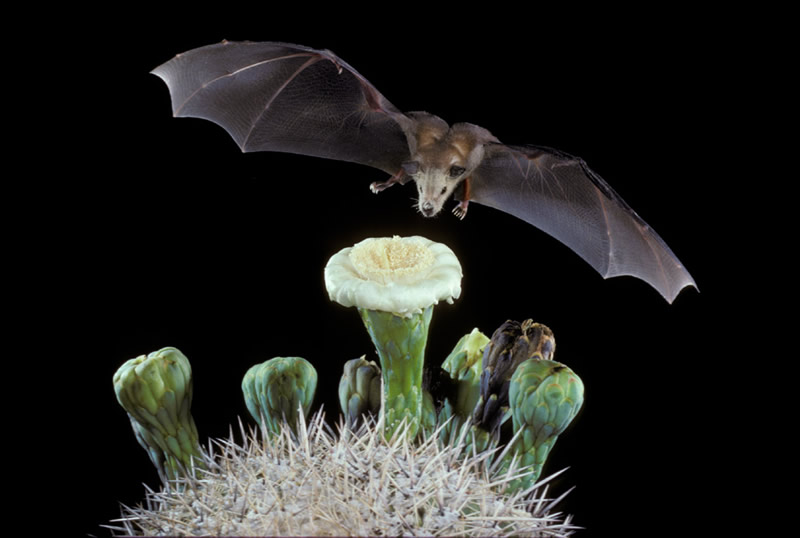What is there to like about bats? Not a lot, one would think, as fears of diseased, night-flying, hairy blood-drinkers come to mind. We slap them on Halloween decorations with reckless abandon and no horror movie would be complete without them. Despite their best efforts, they are yet to be acknowledged by many cultures as anything other than pests. Smear campaign aside, however, humans owe them a lot. They are ecosystem engineers and pollinators of some surprisingly common crops like durian and mango. Most people know insect pollinators are in trouble, but few know that bats are too. Worldwide, 80% of bat species need conservation or research attention. Researchers from the University of Southampton answered just how important bat pollination is, by studying these elusive creatures in rural Mexico.
In the fields of Jalisco State, farmers have grown pitaya fruit from cacti (Stenocereus queretaroensis) for thousands of years. They are colourful, hardy and sell for a high price. Already an important subsistence crop, they are becoming commercially farmed too. The wild varieties are also an important food source for the local wildlife. Many different species pollinate the cacti, but the researchers were interested in the role of long-nosed bats (Leptonycteris). By excluding them from the pollination of wild and domesticated pitaya crops across the region, they found that without the bats, fruit production was adversely affected. Across all varieties, the fruit was less sweet and smaller without bat pollination. Yield also dropped by almost 35% even where the plants were pollinated by other animals. Fruit was 46% smaller in the variety grown for economic export.
“The end result of this is that bat-pollinated fruit is less inbred, heavier and sweeter”
So why are the bats so good at pollinating these plants? Using camera traps, the researchers looked at how the animals fed from the flowers. Hairy bats get a lot more pollen on them than smooth-feathered birds and glossy insects. Their high energy requirements also mean that they visit the plants more than most other animals. Farmed pitaya are monoclonal, so entire plantations have the same genetic makeup. Since bats can travel up to 100km a night, they are also capable of spreading genetically distinct pollen across plantations located at great distances apart. The end result of this is that bat-pollinated fruit is less inbred, heavier and sweeter. The fruit is priced by weight, so losing bats means losing local income in rural areas.
While on the one hand, farming in the region benefits enormously from these pollinating bats, actions taken by livestock owners are inadvertently jeopardising their future. The practise of clearing vampire bat roosts, which are targeted because they can carry bovine rabies, also destroys roosts of long-nosed bats. In addition to roost destruction, bats across the Americas are also facing the loss of their feeding habitats to human development. Two out of the three long-nosed bat species are currently in the vulnerable or endangered category. Since there doesn’t seem to be any sign farmers are going to start domesticating bats, the only way to keep them around will be to change attitudes and practices.
We’re only discovering the secret work pollinators do because they’re disappearing before our eyes. Money talks, and putting an economic value on the services provided by biodiversity is one of the ways ecologists get people to care about it. As this study shows, although a plants capacity to produce fruit may be retained even in the absence of a certain pollinator, the quality and quantity of that produce can vary considerably as a result. The majority of bat-pollinated crops are found in tropical and desert regions. These are also belts of economic poverty, where many people’s livelihoods depend on small-scale farming. 85% of global agricultural production is from regionally important crops like the pitaya so the conservation of their pollinators should be a priority. As we lose pollinators, it’s important to study crops such as these which are often overlooked by global markets, if we are to prevent economic hardship on those who are most vulnerable. A pitaya might not be as popular as a banana, but for many people, their lives depend on it.






